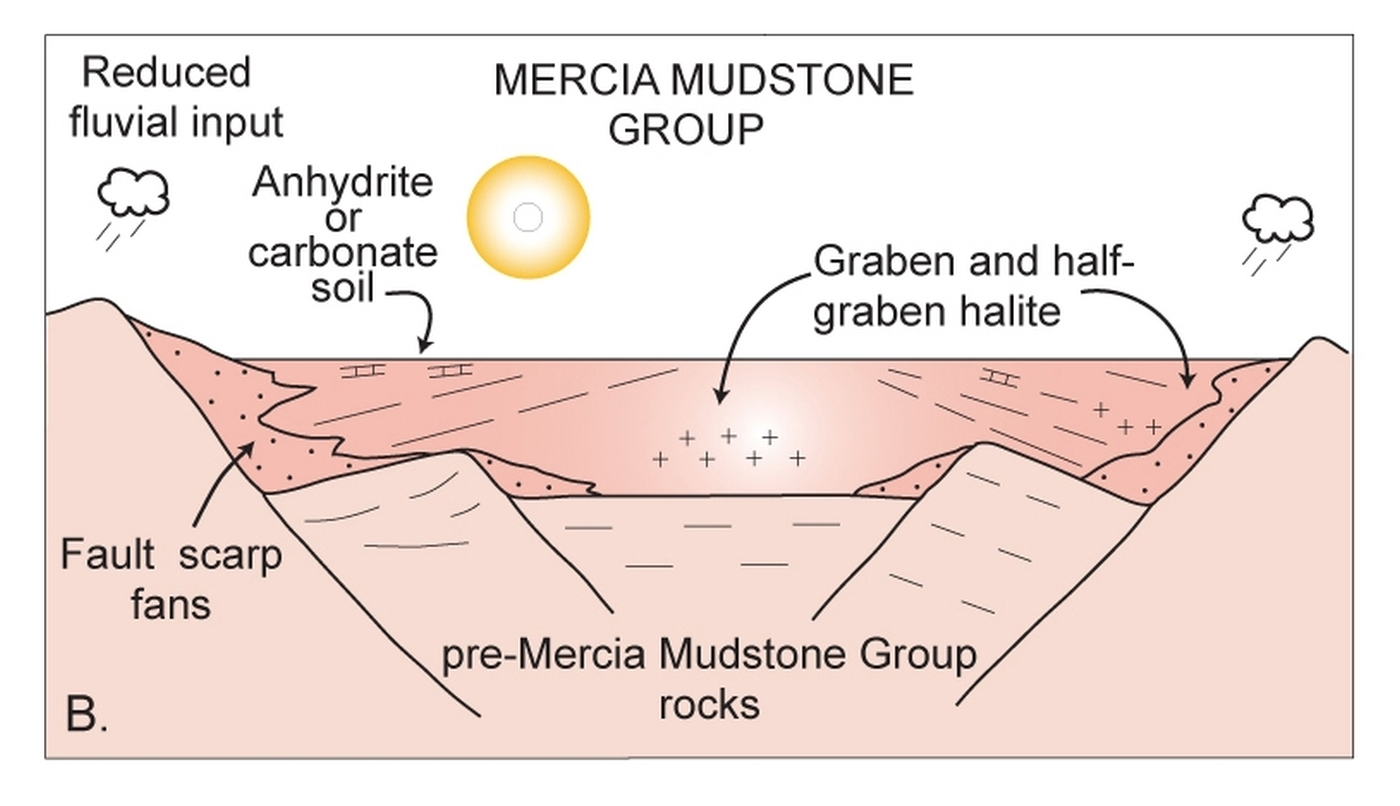Depositional environment and tectono-depositional model for the Triassic in Northern Ireland: Difference between revisions
No edit summary |
m (1 revision imported) |
(No difference)
| |
Revision as of 10:48, 25 September 2017
| Mitchell, W I (ed.). 2004. The geology of Northern Ireland-our natural foundation. Geological Survey of Northern Ireland, Belfast. |
W I Mitchell
Depositional environment (Mercia Mudstone Group, Penarth Group, Waterloo Mudstone Formation)





Arid and semi-arid conditions prevailed in Northern Ireland in Mid-Triassic and early Late Triassic times during deposition of the Mercia Mudstone Group, although the development of thick halite beds requires a marine connection. It is now believed that two different environments existed at this time [1]. A lower, halitic, succession, restricted to southeast Co. Antrim, was deposited in a marine environment subjected to periodic desiccation and was succeeded by anhydritic sediments that were deposited on an arid plain, prone to desiccation, in a lacustrine environment or on a sabkha (P947849).
In the latest Triassic the shallow, hypersaline lagoons in which the sediments of the Collin Glen Formation (Mercia Mudstone Group) were deposited heralded the approach of a marine transgression. At the outset, the succeeding Penarth Group was deposited during a period of fluctuating sea-levels in a shallow epeiric sea in which salinity changes may have caused mass mortality of bivalves and fish faunas. Desiccation cracks in the Langport Member of the Lilstock Formation (P947940) resulted from periodic exposure of the sea bed. With the continued advance of the marine transgression the rocks of the Pre-planorbis beds and the remainder of the Waterloo Mudstone Formation were deposited in deeper water, open marine conditions that were established by the end of Rhaetian times and persisted into the Jurassic.
Tectono-depositional model for the Triassic in Northern Ireland
Traditional models of Triassic sedimentation assumed that the transition from coarse- to fine-grained sediments accompanied a decline in the rate of movement on basin bounding syn-sedimentary faults. Thus the largely fluvial Sherwood Sandstone Group possibly consisted of sediment eroded from the remnants of the Variscan Mountains during a phase of syn-rift crustal extension. Sediment was transported by a periodic influx of floodwater from higher ground and deposited in braided river systems and on alluvial fans. The Mercia Mudstone Group was presumed to have been deposited in an evaporitic seaway during a post-rift phase of thermal subsidence 
 .
.
However, palynological investigations of deep boreholes in the Larne-Lough Neagh basin revealed thickness variations primarily in the Mercia Mudstone Group [2]. Based on the first downhole occurrence of the miospore Tsugaepollenites oriens (P948077) Fossil 9 the evidence restricts the period of maximum subsidence and sediment accumulation to the early Mid-Triassic (Anisian) Craiganee and Glenstaghey formations. By way of comparison, the post-Sherwood Sandstone Group Triassic rocks at Larne are about 1000 m thick of which the Anisian section, including halite units, accounts for 722 m and accumulated over a period of about 7Ma. Succeeding Ladinian-Norian rocks are only 285 m thick but represent a time span of up to 25Ma. Further evidence, based on an interpretation of seismic images, demonstrates that the Mercia Mudstone Group, rather than the Sherwood Sandstone Group, thickens markedly into faults [3] 
 . In the Mercia Mudstone Group, marine incursions resulted in the formation of localised halites and were accompanied by sediment thickening in the hanging wall of active faults. Syn-depositional faulting in the Sherwood Sandstone Group is now believed to represent residual movement superimposed on thermal subsidence, that post-dates earlier Permian regional extension.
. In the Mercia Mudstone Group, marine incursions resulted in the formation of localised halites and were accompanied by sediment thickening in the hanging wall of active faults. Syn-depositional faulting in the Sherwood Sandstone Group is now believed to represent residual movement superimposed on thermal subsidence, that post-dates earlier Permian regional extension.
References
- ↑ Warrington, G. 1981. The indigenous micropalaeontology of the British Triassic shelf sea deposits. In: Neale, J W, and Brasier, M D (eds.). Microfossils from recent and fossil shelf seas. Ellis Horwood, Chichester for British Micropalaeontological Society, 61–70.
- ↑ Warrington, G. 1995. The Permian, Triassic and Jurassic in Northern Ireland: A palynological study with special reference to the hydrocarbon prospectivity of the Larne-Lough Neagh Basin. Geological Survey of Northern Ireland Technical Report GSNI/95/7.
- ↑ Ruffell, A, and Shelton, R. 1999. The control of sedimentary facies by climate during phases of crustal extension: examples from the Triassic of onshore and offshore England and Northern Ireland. Journal of the Geological Society, London, 156, 779–89.